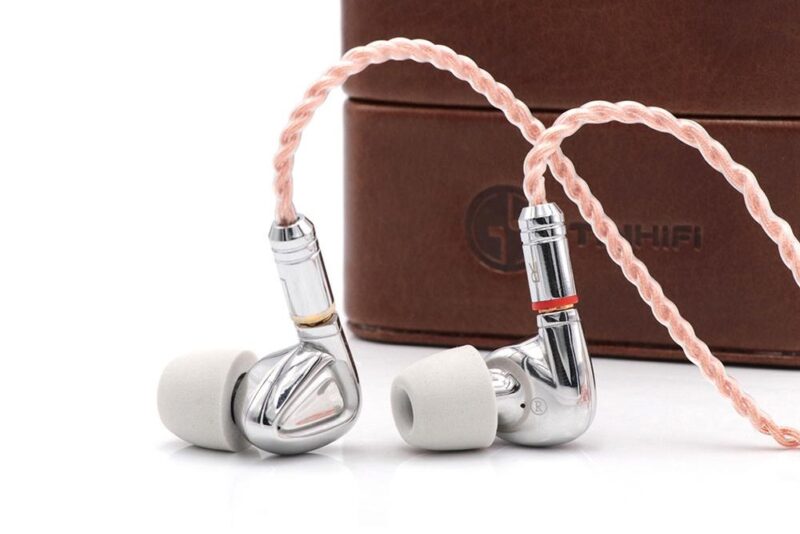I’m a big fan of planar magnetic headphones. They give you presence and detail not possible with most dynamic driver models. Usually, this does come at the expense of some bottom-end punch, but for someone like me, who puts more value into overall balance than visceral thump, this suits me fine.
Because of this, I’ve developed a keen interest in the emerging planar magnetic earphone (IEM) market. This is where the sizeable drivers we’re accustomed to in over-ear planars are miniaturized, making them more amenable to portable use.
It’s a market primarily divided into two camps. One is what I call the “large-format” segment, with earphones that have drivers larger than 10mm (e.g., Audeze Euclid), and the “small-format” segment, with drivers 10mm and below.
As you can imagine, IEMs with more significant drivers usually provide a more full-range sound with more impact on the bottom end. On the other hand, the earphones with smaller drivers typically provide much of the overall detail and musicality of the larger drivers while costing a little (sometimes a lot) less.
Today, we’re looking at the Tin HiFi P1 Plus, which falls into the second camp. These earphones sell for an affordable $169.00 here in the U.S. and have a 10mm planar magnetic driver. It follows the P1 and P2 planar magnetic earphones from Tin HiFi, which have 10mm and 12mm drivers, respectively.
Disclaimer: The Tin HiFi P1 Plus was sent to us by Hifigo.com in exchange for an honest and impartial review. If you think the P1 Plus fits your preferences, pick up a pair from the links in the review to support them. Thanks to them for the opportunity!

As you probably guessed, the P1 Plus is an upgrade of sorts to the P1, adding a new “ultra-thin” diaphragm and a double-sided magnet array (magnets placed on both sides of the driver film), which is supposed to make them sound more natural with less distortion. The double-side magnets also make the Plus version a bit more sensitive, making it easier to drive from portable devices.
The P1 and P1 Plus are pretty much the same as construction is concerned, with the same chrome-finished triangular stainless steel shells and MMCX connectors. The included 5N OFC braided cables look to be similar as well. You also get the same accessory package with two different types of silicone ear tips, foam tips, and a protein leather carrying case.
Accordingly, build quality is still above average for the price point. I love the weight and shine on the earpieces, along with the flexibility/tangle resistance of the cable. The included carrying case (or box) is also really quite lovely.

That said, I have a bone to pick with the P1 Plus, and that would be in the fit area. I usually have problems using IEMs with shorter nozzles, which is the case here. I couldn’t get a seal with any of the included silicone tips because they didn’t go deep enough into my ear. Due to this, the P1 Plus sounded thin at first.
The larger set of foam tips ended up being my saving grace. They were the only tips that gave me a seal and let me hear the P1 Plus’ entire range. YMMV. The foam tips also ended up making them more comfortable to wear, as they pushed the stainless steel housings out a bit, so they didn’t contact my inner ear.
Manufacturer Specs:
Driver: 10mm planar diaphragm
Impedance: 22 Ω ± 15%
Sensitivity: 108±3dB @1K Hz V0.179V
Frequency range: 10 Hz–20kHz
Cable: 1.25m {(18/0.06) oxygen-free copper+ 200d Kevlar) *3 strands }Φ1.3 * 4 strands woven translucent orange PVC cable
Interface: Gold-plated MMCX connector
Rated power: 5mW
Max power: 10mW
Max distortion: 1% @1k Hz 0.179V
Sound
For my listening tests, I hooked the P1 Plus up to my FiiO M11 Plus digital audio player and played some MQA tracks from TIDAL. While the P1 Plus is more sensitive than its predecessor, the P1, it still requires a source with some gusto to get them going at their full potential. The M11 Plus was up to the task, albeit on the high gain setting.
The P1 Plus has a neutral tonal balance with a slight lift at the extreme ends of the spectrum. This makes sound full of depth and detail through the mids, with a bit of air up top, and a little rumble in the sub-bass.

While there is a little air due to the lift in the upper treble, the overall presence is curtailed since the upper mids are pretty flat. Interestingly, the upper mids can still be shouty at points where high-pitched sounds are prominent. Even so, this happens in very brief intervals. For the most part, the upper mids are kept under control, and I like how instruments and vocals are handled.
I think the portion of the tuning some may find more objectionable is the flatness through the midbass, making songs with heavy midbass sound somewhat compressed and blunts dynamics. Those who listen to Hard Rock or certain Hip-Hop tracks may find the low end lacking despite the sub-bass extension.
On the other hand, if you’re like me and you listen to a lot of acoustic and atmospheric music, you may like the “neutral-v” sound for the most part.
As far as detail goes, the P1 Plus exhibits something of a “planar” sound with some clarity and bite, especially in the midrange. Like all the Tin-HiFi earphones, they do a decent job of reproducing the trailing edges of notes and the atmospherics of the recording space. But surprisingly, they manage this without the edginess you hear in some of their dynamic earbuds.

That said, they don’t give you quite the separation or sense of space you would get from a similarly priced Balanced Armature earphone (e.g., Etymotic Research ER3XR).
However, the P1 Plus definitely will give more warmth and weight than the BA earphone. In addition, they sound more natural for lack of a better word, even if they sound more “colored” overall.
As far as soundstage goes, the width is good, going out just beyond the ear, and the depth is also quite lovely, as the P1 Plus is good at giving you layers in the presentation. Even so, imaging is just ok, as the separation isn’t really good enough to provide laser focus on elements in the mix.

Overall, I found the P1 Plus’ sound a mixed bag. With certain music like Carey Bell’s funky Blues track “Sweet Little Woman,” the P1 Plus was resplendent, playing fast with fantastic musicality. Bell’s vocal was gritty and in your face, just like you would expect from a bluesman, and his guitar was vibrant and full of life.
But on tracks like the Black Pumas’ “Colors,” they fell kind of flat, with the drum line missing the slam and punch I’m used to.
The Wrap Up
In conclusion, the Tin HiFi P1 Plus is a beautifully built pair of earphones that are pretty comfortable to boot (Once you find an ear tip to fit). The sound is up and down depending on the genre, with Rock and Hip-hop sounding a little flat, but acoustic genres like Blues or Jazz sounding quite engaging. So if you’re looking for an affordable Planar earphone that excels for that kind of music, then the P1 Plus could be what you’re looking for.
Hifitrends is reader-supported. When you purchase through links on our site, we may earn an affiliate commission.

I’m an audio writer who started as a young audio salesman/consumer electronics professional back in the late 90s. That’s where I discovered the magic of 2-Channel sound. My hunger for great sound has led me on a delightful music quest that continues today.



Leave a Reply